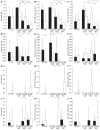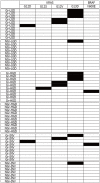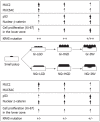MUC5AC/β-catenin expression and KRAS gene alteration in laterally spreading colorectal tumors
- PMID: 23112547
- PMCID: PMC3482641
- DOI: 10.3748/wjg.v18.i39.5551
MUC5AC/β-catenin expression and KRAS gene alteration in laterally spreading colorectal tumors
Abstract
Aim: To clarify differences in mucin phenotype, proliferative activity and oncogenetic alteration among subtypes of colorectal laterally spreading tumor (LST).
Methods: LSTs, defined as superficial elevated lesions greater than 10 mm in diameter with a low vertical axis, were macroscopically classified into two subtypes: (1) a granular type (Gr-LST) composed of superficially spreading aggregates of nodules forming a flat-based lesion with a granulonodular and uneven surface; and (2) a non-granular type (NGr-LST) with a flat smooth surface and an absence of granulonodular formation. A total of 69 LSTs, comprising 36 Gr-LSTs and 33 NGr-LSTs, were immunohistochemically stained with MUC2, MUC5AC, MUC6, CD10 (markers of gastrointestinal cell lineage), p53, β-catenin and Ki-67 antibodies, and examined for alteration in exon 1 of v-Ki-ras2 Kirsten rat sarcoma viral oncogene homolog (KRAS) and exon 15 of v-raf murine sarcoma viral oncogene homologue B1 (BRAF) by polymerase chain reaction followed by direct sequencing.
Results: Histologically, 15 Gr-LST samples were adenomas with low-grade dysplasia (LGD), 12 were high-grade dysplasia (HGD) and 9 were adenocarcinomas invading the submucosa (INV), while 12 NGr-LSTs demonstrated LGD, 14 HGD and 7 INV. In the proximal colon, MUC5AC expression was significantly higher in the Gr-type than the NGr-type. MUC6 was expressed only in NGr-LST. MUC2 or CD10 did not differ. P53 expression demonstrated a significant stepwise increment in progression through LGD-HGD-INV with both types of LST. Nuclear β-catenin expression was significantly higher in the NGr-type. Ki-67 expression was significantly higher in the Gr-type in the lower one third zone of the tumor. In proximal, but not distal colon tumors, the incidence of KRAS provided mutation was significantly higher in the Gr-type harboring a specific mutational pattern (G12V). BRAF mutations (V600E) were detected only in two Gr-LSTs.
Conclusion: The two subtypes of LST, especially in the proximal colon, have differing phenotypes of gastrointestinal cell lineage, proliferation and activation of Wnt/β-catenin or RAS/RAF/extracellular signal-regulated kinase signaling.
Keywords: Adenoma-carcinoma sequence; Colon; Direct sequencing; Immunohistochemistry; Laterally spreading tumor; Mucin core protein; v-Ki-ras2 Kirsten rat sarcoma viral oncogene homolog; β-catenin.
Figures






Similar articles
-
Methylation epigenotypes and genetic features in colorectal laterally spreading tumors.Int J Cancer. 2014 Oct 1;135(7):1586-95. doi: 10.1002/ijc.28814. Epub 2014 Mar 10. Int J Cancer. 2014. PMID: 24590867
-
Mutational profiles of different macroscopic subtypes of colorectal adenoma reveal distinct pathogenetic roles for KRAS, BRAF and PIK3CA.BMC Gastroenterol. 2014 Dec 31;14:221. doi: 10.1186/s12876-014-0221-y. BMC Gastroenterol. 2014. PMID: 25551625 Free PMC article.
-
Macroscopic morphologic subtypes of laterally spreading colorectal tumors showing distinct molecular alterations.Int J Cancer. 2010 Oct 1;127(7):1562-9. doi: 10.1002/ijc.25180. Int J Cancer. 2010. PMID: 20091866
-
Gastric pyloric gland adenoma.Arch Pathol Lab Med. 2015 Jun;139(6):823-6. doi: 10.5858/arpa.2013-0613-RS. Arch Pathol Lab Med. 2015. PMID: 26030253 Review.
-
Exploring the role of sporadic BRAF and KRAS mutations during colorectal cancer pathogenesis: A spotlight on the contribution of the endosome-lysosome system.Cancer Lett. 2024 Mar 31;585:216639. doi: 10.1016/j.canlet.2024.216639. Epub 2024 Jan 28. Cancer Lett. 2024. PMID: 38290660 Review.
Cited by
-
Comparison of the histopathological characteristics of large colorectal laterally spreading tumors according to growth pattern.J Anus Rectum Colon. 2019 Oct 30;3(4):152-159. doi: 10.23922/jarc.2018-036. eCollection 2019. J Anus Rectum Colon. 2019. PMID: 31768465 Free PMC article.
-
Mechanistic and Functional Shades of Mucins and Associated Glycans in Colon Cancer.Cancers (Basel). 2020 Mar 11;12(3):649. doi: 10.3390/cancers12030649. Cancers (Basel). 2020. PMID: 32168759 Free PMC article. Review.
-
Colorectal cancer in Crohn's colitis is comparable to sporadic colorectal cancer.Int J Colorectal Dis. 2016 May;31(5):973-982. doi: 10.1007/s00384-016-2574-x. Epub 2016 Mar 30. Int J Colorectal Dis. 2016. PMID: 27026089
-
[Expression of Wnt and integrin pathways in colorectal laterally spreading tumors and their correlation with endoscopic subtypes].Nan Fang Yi Ke Da Xue Xue Bao. 2017 Sep 20;37(9):1234-1241. doi: 10.3969/j.issn.1673-4254.2017.09.16. Nan Fang Yi Ke Da Xue Xue Bao. 2017. PMID: 28951368 Free PMC article. Chinese.
References
-
- Vogelstein B, Fearon ER, Hamilton SR, Kern SE, Preisinger AC, Leppert M, Nakamura Y, White R, Smits AM, Bos JL. Genetic alterations during colorectal-tumor development. N Engl J Med. 1988;319:525–532. - PubMed
-
- Cho KR, Vogelstein B. Genetic alterations in the adenoma-carcinoma sequence. Cancer. 1992;70:1727–1731. - PubMed
-
- Samowitz WS, Powers MD, Spirio LN, Nollet F, van Roy F, Slattery ML. Beta-catenin mutations are more frequent in small colorectal adenomas than in larger adenomas and invasive carcinomas. Cancer Res. 1999;59:1442–1444. - PubMed
-
- Wong SC, Lo ES, Lee KC, Chan JK, Hsiao WL. Prognostic and diagnostic significance of beta-catenin nuclear immunostaining in colorectal cancer. Clin Cancer Res. 2004;10:1401–1408. - PubMed
Publication types
MeSH terms
Substances
LinkOut - more resources
Full Text Sources
Medical
Research Materials
Miscellaneous

